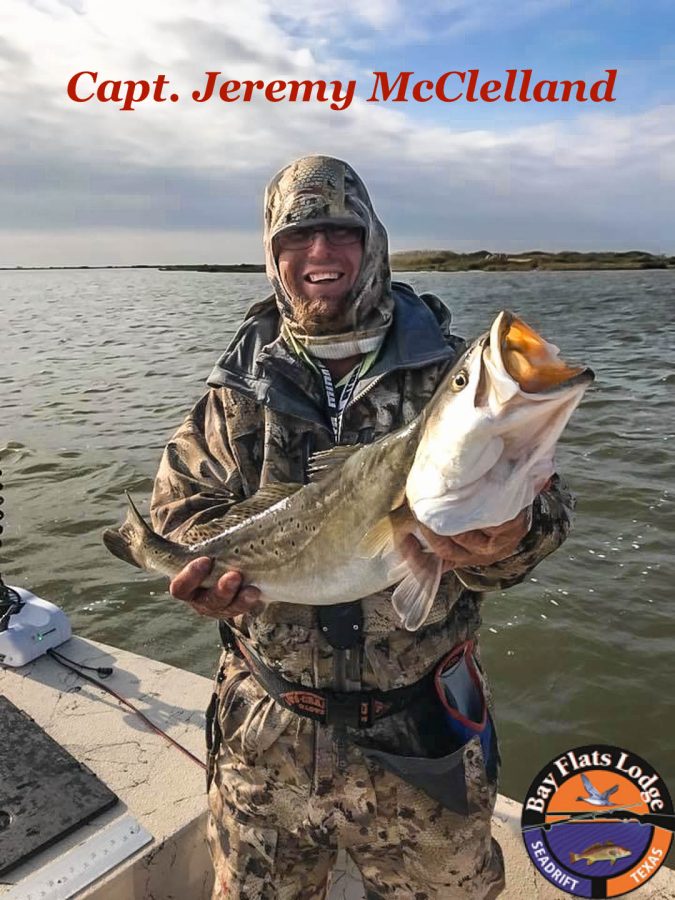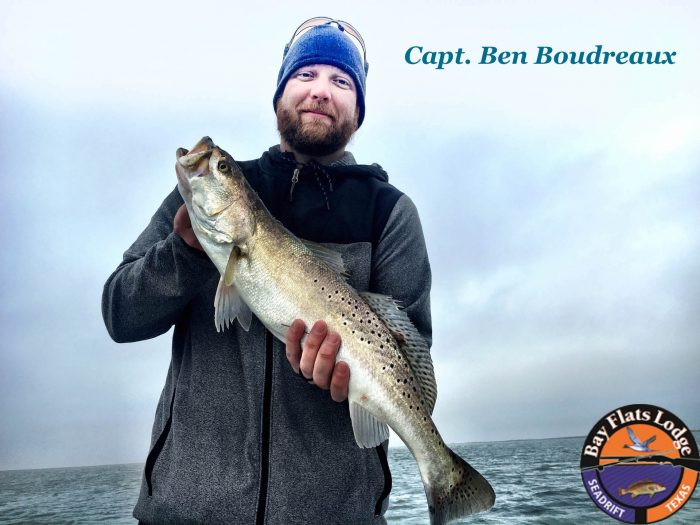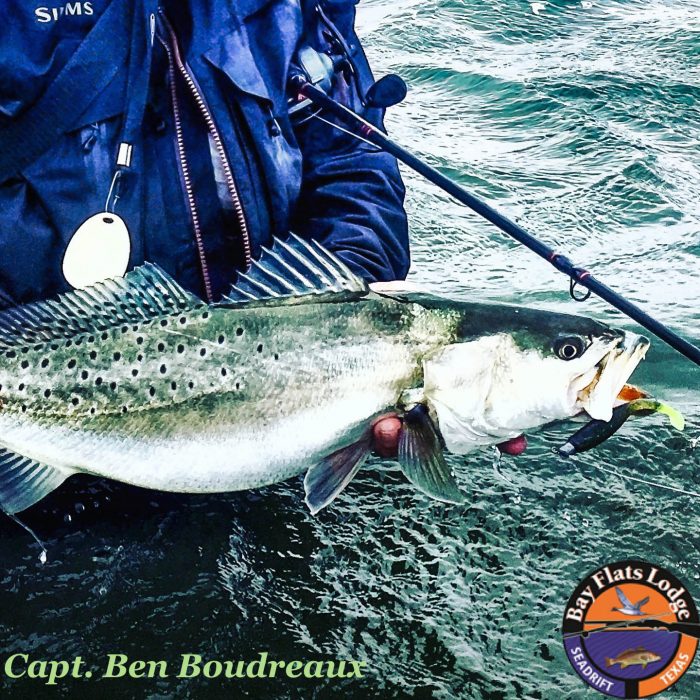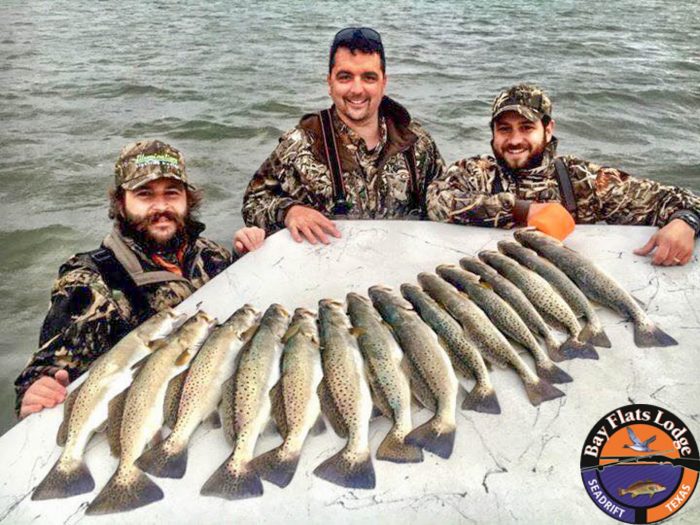by Capt. Chris Martin
Naturally, it is during winter when we begin noticing an increase in the frequency of frontal passages from the north. And if you have ever fished for trout or redfish along the Texas coast this month, then you know quite well that you may encounter foul weather on any given day. This increased rate of frontal passages means there is a good possibility that there will also be a lot of variation in water levels, water clarity, and wind direction and speed. And to top things off, it’s going to be cold when you’re out there fishing in all of this.
But don’t you worry, as the fish will be cold too. They’ll be looking for a warm place to snuggle-down and rest for a while whenever a strong frontal passage rolls through town that drops air and water temps considerably. They’ll be looking for places where the bay floor consists primarily of thick, dark mud that may be spotted occasionally by grass or shell. Mud serves as a solar-panel of sorts in that it soaks up the day’s heat and then releases the heat throughout the night and day. Because of this, fish will naturally stay close to the mud bottom during periods of extreme cold. Another prime wintertime spot is shell. Shell offers protection and cover to small baitfish, so if the bait happens to be hiding within a shell environment, you can almost always anticipate that the trout and the red fish may very well be gathered in the same area.
Because the number of days between fronts can be minimal right now, anglers may not have the option of waiting a certain period of time after the passage of a front before they head out in search of their cold-water treasure. Instead, a lot of winter coastal anglers will probably be forced to endure a significant amount of wind change while fishing. This may also mean that a lot of anglers may not be able to find a huge amount of really clear water to fish in each time they’re out wandering around the bay. But don’t let this dampen your hopes at success. You can experience an epic day of fishing on a muddy shoreline even right after a front has passed.
When you’re out fishing right after a passing cold front, look for a patch of fairly shallow real estate that is protected from the strong north wind. There’s a good chance you’ll find bait activity in the area simply due to the fact that just before the arrival of yesterday’s front the wind was pumping out of the south, pushing baitfish tight against the north shoreline areas. That same strong south wind will have also muddied the water of this north shoreline considerably, but don’t let that bother you – where there’s baitfish, there’s almost certain to be game fish.
Park the boat in waist-deep water, and start your wade session at that depth while casting into more shallow water toward the bank. When doing this, you may wish to consider throwing some of the heavier models of top water baits that contain loud rattles, because you will typically be attempting to cast directly into a fairly stiff north wind. As you slowly make your way toward the shallow water, make note of any troughs or slight inundations you may come across. As you walk into these small guts, turn to either side and cast your bait directly down the somewhat deeper water that you’ve just stepped-off into. Water temperature often varies by depth, so even a few inches might mean a couple degrees difference in warmth to a big wintertime sow trout, especially throughout the colder months.
If you’re out fishing immediately following a major cold front and are able to make your way across to some of the more secluded back lakes, take advantage of the opportunity. These secluded backwater areas will not see a lot of boat traffic this time of the year which means these areas will not have been fished by many people. It will be quiet, and you may feel alone, but that’s not a bad thing at all. In fact, it can be rather welcomed whenever you’re hunting for a trophy trout in cold water. Enjoy the solitude, and accept an opportunity to boast your success when you get back to the cleaning table at the end of the day.
Whenever you’re fishing in the back lakes out on Matagorda Island during the winter months, you might like to experiment with your artificial baits both above and below the surface of the water. You should toss top water baits only whenever conditions are ideal for doing so – this generally means cloud cover over shallow areas consisting of heavy mud and grass, with a bit of wind and off-colored water. If you happen upon some really clear water conditions when you’re in the back lakes, present some of your favorite plastic baits, especially some of the suspending baits. But, regardless of tops or tails, when it comes to lure colors for wintertime speckled trout fishing, you should always try to make it a point to stick primarily to the dark colors with bright accents – colors like pumpkinseed, plum, and black, all with chartreuse accents. There is, however, one exception to the dark-color rule that you should allow yourself to make, and that’s a pink slow-sinking, plastic bait that still remains quite productive to this day. You can find a lot of anglers throwing this particular lure throughout the entire year, as few have found that the action and efficiency it accounts for in cooler water conditions can seldom be matched.
For those coastal anglers looking primarily for wintertime redfish, place your focus on the same basic environmental and structural elements – shell, mud, and baitfish – but learn to look for your prizes in some of the more shallow waters. Redfish are hardier than trout, especially when it’s really cold, so they can handle some extremely shallow water. And all of the fish will probably be moving a lot slower right now, so above all else, remember the necessity for patience, and the importance for you to keep grindin’!




